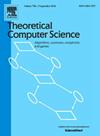The complexity of boolean failure identification
IF 1
4区 计算机科学
Q3 COMPUTER SCIENCE, THEORY & METHODS
引用次数: 0
Abstract
We consider the problem of identifying failure nodes in networks under the Boolean Network Tomography () approach, which is based on end-to-end measurements routed in a network along paths and producing a boolean (failure/not-failure) outcome. Such end-to-end measurements paths are usually described by an incidence boolean matrix with rows (the measurements paths) and columns (the nodes of the network). A key notion used in practice in this approach is that of -identifiability. Loosely speaking, a set of boolean measurements paths over nodes is -identifiable, where is a non-negative integer, if, whenever there are fewer than failures, it is always possible to identify unambiguously and uniquely which nodes are failing.
Following the focus of some recent results analyzing maximal identifiability from a theoretical point of view, this work establishes the complexity of the optimization problem that determines the maximal for which a set of measurement paths is -identifiable (). We prove that such problem is -hard by a reduction from the Minimum Hitting Set problem and we prove that its decision version is in .
We further consider the following extremal combinatoric question, which is also of practical relevance: given the number of nodes of the network and a non-negative integer value for the identifiability, what is the minimal number of measurement paths over the nodes to consider in such a way that the maximal identifiability is at least ? A folklore result shows that to have maximal identifiability at least 1, then (or, equivalently, that if , then the maximal identifiability is less than or equal 0). In this work we answer this question for each and for each , proving that, there is constant such that if , then the maximal identifiability value is strictly smaller than (and when , suffices).
Finally, we study upper and lower bounds on the number of unambiguously identifiable nodes, introducing new identifiability conditions which strictly imply and are strictly implied by unambiguous identifiability. We use these new conditions to design algorithmic heuristics to count defective nodes in a fine-grained way. In particular we introduce a random model to study lower bounds on the number of unambiguously identifiable defective nodes and we use this model to estimate lower bounds on the number of identifiable nodes on real networks by a maximum likelihood estimate approach.
布尔故障识别的复杂性
我们考虑在布尔网络断层扫描(BNT)方法下识别网络中故障节点的问题,该方法基于沿路径在网络中路由的端到端测量,并产生布尔(故障/非故障)结果。这种端到端测量路径通常由关联布尔矩阵M描述,其中包含M行(测量路径)和n列(网络节点)。这种方法在实践中使用的一个关键概念是k-可识别性。粗略地说,n个节点上的m个布尔测量路径的集合是k可识别的,其中k是一个非负整数,如果,无论何时有少于k+1个失败,总是有可能明确和唯一地识别哪些节点失败。根据最近一些从理论角度分析最大可识别性的结果的重点,本工作建立了优化问题的复杂性,该问题决定了一组测量路径的最大k (MID)。通过对最小命中集问题的约简,证明了该问题是NP-hard问题,并证明了其决策版本是NP的。我们进一步考虑以下极值组合问题,这也具有实际意义:给定网络的节点数n和可辨识性的非负整数值k,在n个节点上考虑的测量路径的最小个数m是多少,以使最大可辨识性至少为k?一个民间研究结果表明,要使最大可辨识性至少为1,则m≥log(n+1)(或等价地,如果n>;2m−1,则最大可辨识性小于等于0)。在本文中,我们回答了这个问题,对于每个n∈n,对于每个k≥2,证明了存在一个常数C,使得当n>;Cmm +mk−1时,最大可辨识值严格小于k(且当k=2时,n>;Cmm足够)。最后,我们研究了无二义可识别节点数目的上界和下界,引入了严格隐含和严格隐含无二义可识别性的新的可识别条件。我们使用这些新的条件来设计启发式算法,以细粒度的方式计算缺陷节点。特别地,我们引入了一个随机模型来研究无歧义可识别缺陷节点数目的下界,并用极大似然估计方法来估计真实网络中可识别节点数目的下界。
本文章由计算机程序翻译,如有差异,请以英文原文为准。
求助全文
约1分钟内获得全文
求助全文
来源期刊

Theoretical Computer Science
工程技术-计算机:理论方法
CiteScore
2.60
自引率
18.20%
发文量
471
审稿时长
12.6 months
期刊介绍:
Theoretical Computer Science is mathematical and abstract in spirit, but it derives its motivation from practical and everyday computation. Its aim is to understand the nature of computation and, as a consequence of this understanding, provide more efficient methodologies. All papers introducing or studying mathematical, logic and formal concepts and methods are welcome, provided that their motivation is clearly drawn from the field of computing.
 求助内容:
求助内容: 应助结果提醒方式:
应助结果提醒方式:


